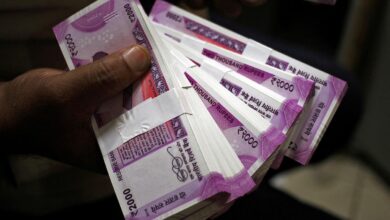Central bankers across Southeast Asia are trying to time rate cuts to ensure their currencies don’t collapse

As 2024 began, Fed watchers thought it was a matter of when, not if, the U.S. central bank would cut interest rates. Four months into the year, most aren’t quite so optimistic: The Federal Reserve now is signaling that it’s in no rush to cut rates, thanks to a more resilient than expected U.S. economy and “sticky” inflation.
But analysts and investors aren’t alone in trying to predict what the Fed will do: Central bankers around the world, including Asia, are also closely watching the Federal Reserve to gauge their own interest rate decisions—to cut, hold steady, or even to hike rates.
In the most recent example of this delicate dance, Bank Indonesia, that country’s central bank, surprised analysts on Wednesday when it raised a key interest rate by 25 basis points to 6.25% in an effort to strengthen the rupiah, Indonesia’s currency, which has been stumbling against the strength of the dollar. Only six of 35 economists polled by Reuters predicted the rate hike, the first since October.
Emerging markets, like Indonesia and those throughout Southeast Asia, are in a bind. Cutting interest rates would alleviate pressure on the economy, lower borrowing costs and spur growth. But cut too early—particularly if the Fed keeps things “higher for longer”—and capital outflows caused by investors searching for higher rates could lead to a weaker currency.
In fact, the current strength of the U.S. dollar means that we aren’t going to see rate cuts in Asian markets anytime soon, says Jingyi Pan, the economics associate director of the PMI team at S&P Global Market Intelligence.
“Central banks in Asia are generally reluctant to see their domestic currency fluctuate significantly against other currencies, especially the U.S. dollar, and may therefore be less keen to move ahead of the Fed,” she says.
Cut, hold steady, or hike?
Higher U.S. interest rates tend to lead to a stronger dollar, as investors move money to the country in search of higher returns on bonds and other interest-rate products. The added demand leads to a strengthening dollar.
Central banks around the world thus are now finding that they need to hold or raise their own interest rates in order to avoid capital outflow and support their own currencies. A weaker currency makes essential imports like food and energy more expensive, worsening inflation.
On Wednesday, Perry Warjiyo, governor of Indonesia’s central bank, said the country’s surprise hike to its key interest was meant to “strengthen the stability of the rupiah exchange rate.” The Indonesian rupiah has fallen close to 5% against the U.S. dollar this year, even after accounting for Wednesday’s rate decision.
And it’s not only the Indonesian central bank that’s paying attention to pressures from the dollar.
The Thai central bank has held its key interest rate steady at 2.5% despite calls for rate cuts by Prime Minister Srettha Thavisin, who points to slower growth in Southeast Asia’s second-largest economy in comparison to its regional peers. “Vulnerable groups like SMEs have a problem with a high interest rate,” he said in a recent interview with reporters.
Yet cutting rates could be risky, as it could lead to further weakening of the baht. The baht has slipped around 8% against the U.S. dollar this year.
Snubbed by the central bank, Srettha asked Thailand’s major financial institutions to lower rates instead. On Thursday, four major Thai banks agreed to temporarily lower borrowing costs after their CEOs met with the Thai prime minister.
The strong U.S. dollar is also pressuring the Malaysian ringgit and the Philippine peso; both Southeast Asian central banks have so far maintained their benchmark interest rates.
The Philippine central bank previously signaled that it might cut rates later this year or early next year—yet Ralph Recto, the country’s financial secretary, warned that the Philippines might maintain its benchmark rate of 6.5% if the peso weakens past its current record low of 59 per dollar. On Thursday, Recto told Bloomberg that the peso’s slump is unlikely to spur the central bank to raise its key interest rates from a 17-year high at this time.
Elevated U.S. interest rates and a strong U.S. dollar also affect trade returns. Pan notes that Asia markets, excluding Japan, have remained relatively subdued this year, despite S&P’s PMI surveys showing positive economic performance. Businesses in the region are reporting rising input costs as their local currencies slide against the dollar. (Commodities are most often traded in dollars, meaning a strong greenback would raise costs for many companies.)
South Korea and Japan
It’s not just Southeast Asia that’s feeling the heat of the strong dollar.
South Korea, which raised interest rates before the U.S. central bank, has so far kept its rates steady even as businesses struggle with high borrowing costs. The Bank of Korea has maintained its key interest rate at 3.5% since early last year.
Still, the won has slipped by over 5% against the dollar this year. Last week, Rhee Chang-Yong, the Bank of Korea’s governor, said the country was ready to “deploy stabilizing measures” to support the won.
Japan has also seen a sharp depreciation of the yen against the dollar. Japan’s currency hit its lowest level in over three decades on Wednesday, at 155 versus the dollar.
Japan’s companies have traditionally supported a weak yen, as it makes exports cheaper overseas. Inbound tourism to Japan has also surged thanks to a weak yen.
But firms are now warning that the yen might be too weak, sending input prices higher and worsening inflation in the country. In a conversation with reporters, Japan Airlines CEO Mitsuko Tottori suggested that business leaders would be more comfortable with an exchange rate of around 130 yen to the U.S. dollar.
Japanese officials have said they’ll step in to support the yen if the currency depreciates too quickly. Japan intervened in foreign exchange markets three times in 2022 to prop up its currency.
Last week, Japan, South Korea and the U.S. released a statement that acknowledged the two Asian countries’ “serious concerns” about “recent sharp depreciation” of their currencies.
This story was originally featured on Fortune.com





